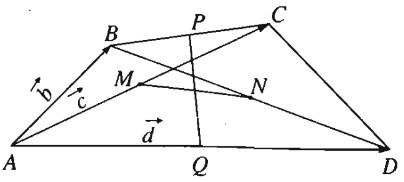Cho tứ giác ABCD. Gọi M, N, P, Q lần lượt là trung điểm của các đoạn AC, BD, AD và có MN = PQ . Chứng minh rằng AB ⊥ CD.


Ta cần chứng minh \(\overrightarrow {AB} .\overrightarrow {C{\rm{D}}} = 0\)
Đặt \(\overrightarrow {AB} = \overrightarrow b ,\,\,\overrightarrow {AC} = \overrightarrow c ,\,\,\overrightarrow {AD} = \overrightarrow d \). Ta có:
\(\overrightarrow {MN} = \overrightarrow {MA} + \overrightarrow {AN} = - {1 \over 2}\overrightarrow {AC} + {1 \over 2}\left( {\overrightarrow {AB} + \overrightarrow {AD} } \right)\)
Advertisements (Quảng cáo)
Suy ra \(\overrightarrow {MN} = {1 \over 2}\left( {\overrightarrow b + \overrightarrow d - \overrightarrow c } \right)\)
\(\eqalign{
& \overrightarrow {QP} = \overrightarrow {QA} + \overrightarrow {AP} \cr
& = - {1 \over 2}\overrightarrow {A{\rm{D}}} + {1 \over 2}\left( {\overrightarrow {AB} + \overrightarrow {AC} } \right) \cr
& = {1 \over 2}\left( {\overrightarrow b + \overrightarrow c - \overrightarrow d } \right) \cr} \)
Theo giả thiết ta có:
\(MN = PQ \Leftrightarrow {\overrightarrow {MN} ^2} = {\overrightarrow {QP} ^2}\)
\(\eqalign{
& {\left( {\overrightarrow b + \overrightarrow d - \overrightarrow c } \right)^2} = {\left( {\overrightarrow b + \overrightarrow c - \overrightarrow d } \right)^2} \cr
& \Leftrightarrow \overrightarrow b .\overrightarrow d - \overrightarrow b .\overrightarrow c = \overrightarrow b .\overrightarrow c - \overrightarrow b .\overrightarrow d \cr
& \Leftrightarrow 2\overrightarrow b .\overrightarrow d - 2\overrightarrow b .\overrightarrow c = 0 \cr
& \Leftrightarrow \overrightarrow b .\left( {\overrightarrow d - \overrightarrow c } \right) = 0 \cr
& \Leftrightarrow \overrightarrow {AB} .\left( {\overrightarrow {A{\rm{D}}} - \overrightarrow {AC} } \right) = 0 \cr
& \Leftrightarrow \overrightarrow {AB} .\overrightarrow {C{\rm{D}}} = 0 \Leftrightarrow \overrightarrow {AB} \bot \overrightarrow {C{\rm{D}}} \cr} \)
